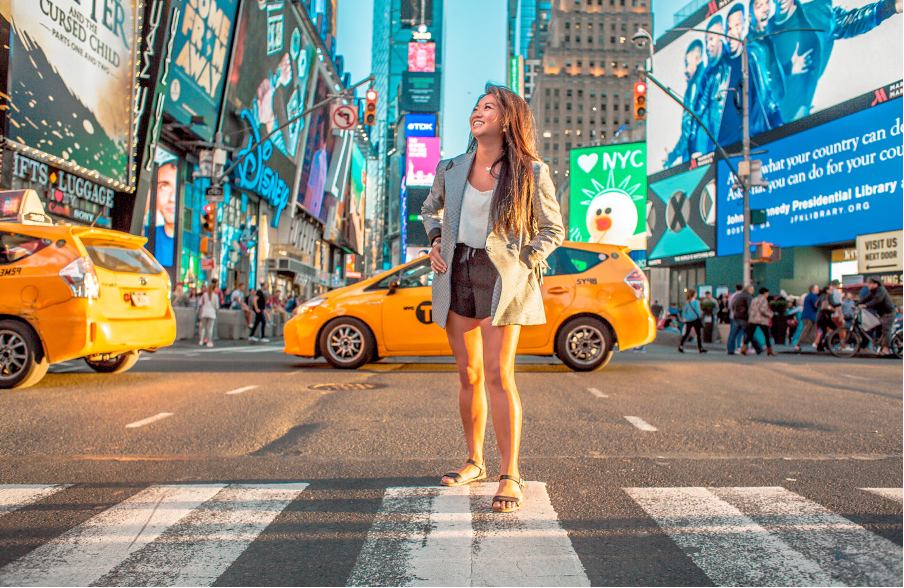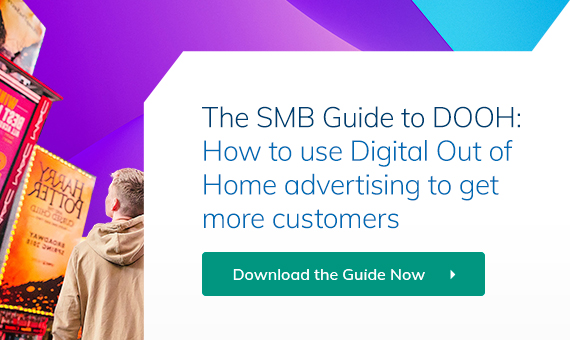In the digital age, it’s never been more difficult to win the attention of consumers.
The online world has become so oversaturated with banner ads and pop-ups that mobile and web users simply don’t notice them anymore – a phenomenon known as “banner blindness”, experienced by some 86% of consumers.
And when they’re not blind to them, they’re positively irritated by them – which is why nearly half (42.7%) of internet users worldwide use ad blocking tools to shut them out of sight.

(Image source: backlinko.com)
It’s for this reason that many of the world’s largest brands – including McDonald’s and Burger King, as well as online giants like Netflix and Google – now turn to digital out of home (DOOH) advertising to raise brand awareness and launch new products and services.
Out of home advertising is one of the oldest and most enduring forms of advertising in existence – and for good reason. Consumers cannot ignore it and it can’t be blocked. With today’s high-quality digital screens and programmatic buying capabilities, advertisers of all shapes and sizes, including SMBs, can take advantage of OOH ads.
Programmatic buying allows any organization to affordably create impressive and memorable DOOH campaigns that target specific audiences in the right place, at the right time, with key messages about their brand’s offers.
What Is Transit Advertising?
DOOH advertising comes in many forms – from giant digital billboards next to busy highways to place-based screens on street furniture and in shopping malls. However, one of the most impactful forms of digital out of home is transit advertising – a mode of advertising that reaches nearly 80% of consumers a month.
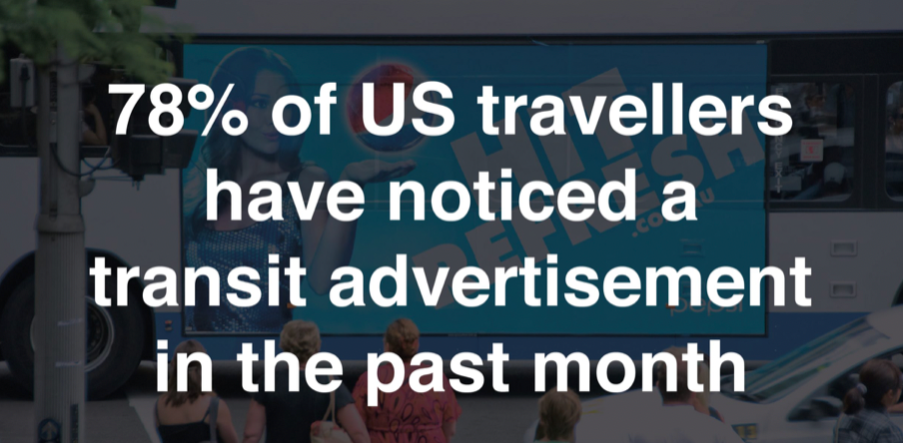
(Image source: contravision.com)
Transit advertising is any form of advertising media placed on, or within, modes of public transportation. Transit media includes bus advertisements – ads in buses, on buses, and at bus stations. It’s subway ads – advertisements in subway cars, on subway cars, and at subway stations. It’s ads on airplanes and at airports, and it’s ads featured on taxis or within them, as well as Ubers, trains, and train stations.
Why Are Transit Ads Effective?
Transit advertising works for many reasons.
For starters, it can’t be ignored or blocked like online advertising can. It also appears in the very places where commuters are waiting idle and looking around for a distraction, essentially a captive audience within a captive environment. Advertising in these confined environments has proven to be very highly engaging, as a study by JCDeaux found that 85% of travellers would respond to an airport advertising message.
Commuters are often confined to specific areas when traveling and as a result, it is extremely difficult to ignore an ad when waiting at a transit station, or when riding a bus, train, taxi, or any other vehicle, as the ad is always right there in front of the consumer. A typical commute lasts about 30 minutes – and commuters usually spend this time looking at their surroundings and included in that, viewing advertisements.
In addition, transit ads enjoy massive audience exposure. Millions of people use public transportation every single day to travel to many different parts of a locality. Often commuters and travellers will use the same transport routes multiple times per day, building a greater level of subconscious interest and engagement as they repeatedly view the same advertisement. This means that no matter if transit advertisers are trying to reach working professionals, people in densely populated areas, weekend shoppers, busy town or city centers, or residential neighborhoods – transit advertising travels with them to each part of the community.
Most importantly, transit advertising helps SMBs reach mass audiences in ways that build brand recognition and drive action – both at transit stations, and on public transportation vehicles.
This is especially true for digital out of home (DOOH) transit advertising.
According to research from the Out of Home Advertising Association of America (OAAA), over 54% of consumers notice DOOH transit advertising at transit stations “all” or “most” of the time. Of these, over two-thirds (67%) engage in further action, such as searching for the advertiser, visiting a website, visiting the store or restaurant being advertised, or visiting or posting to social media.
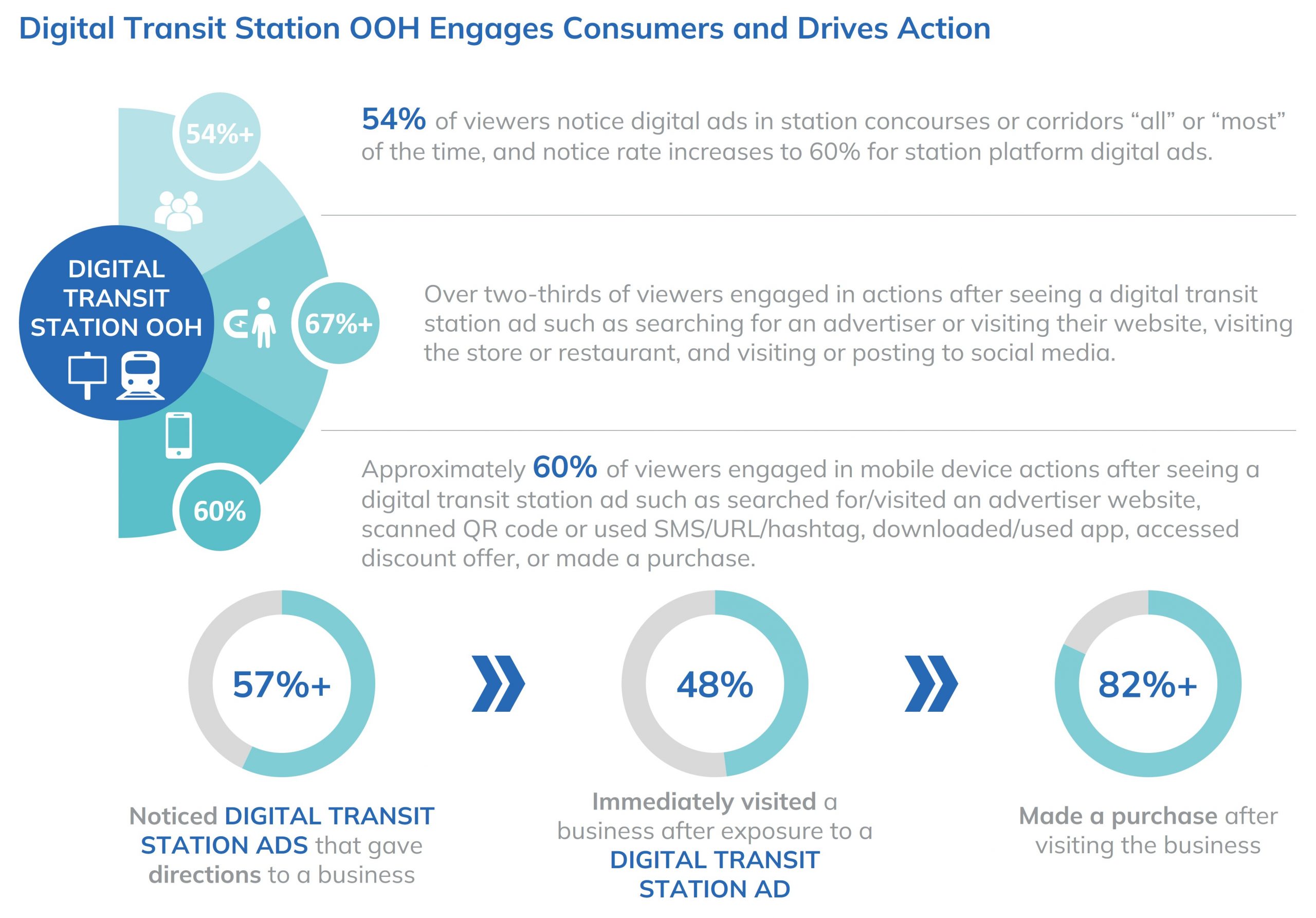
(Image source: oaaa.org)
The OAAA also examined the effects of digital taxi out of home advertising and how it engages consumers and drives action. It found that 51% of consumers notice digital taxi top ads “all” or “most” of the time – increasing to 76% for interior digital taxi ads.
59% engaged in actions after viewing a taxi top ad – and 76% for interior taxi ads.
Furthermore, of the 42% of consumers who noticed a digital taxi advertisement that gave directions to a local business, 63% immediately visited that business, of which 89% made a purchase.
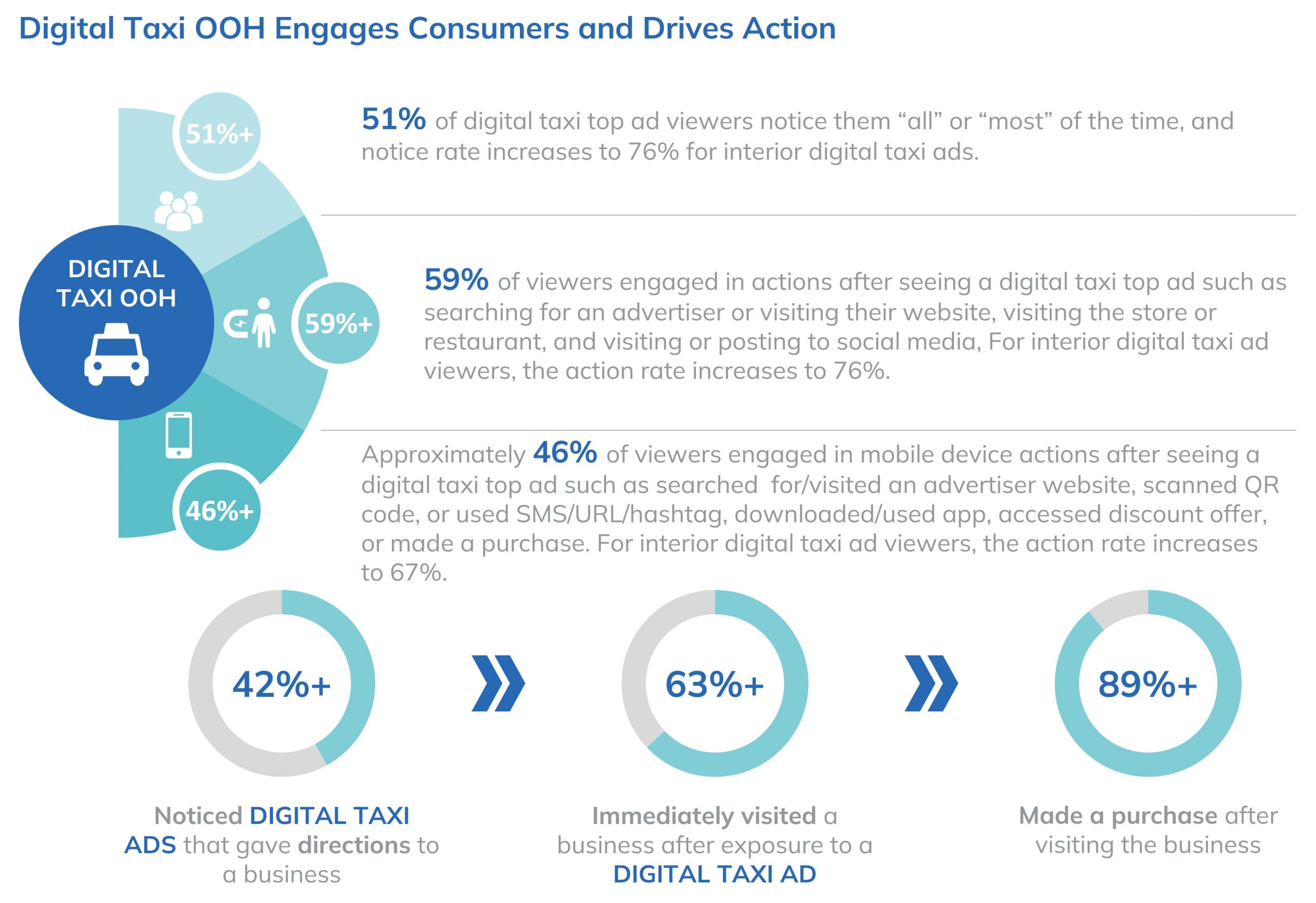
(Image source: oaaa.org)
In another OAAA study that analysed the effectiveness of digital airport OOH, it was found that 54% of consumers notice DOOH ads in airports “most” or “all” of the time. 59% engaged in mobile device actions after seeing a digital airport ad, such as searching for or visiting the advertiser’s website, scanning a QR code, using a hashtag, downloading an advertised app, or accessing a discount offer.
Furthermore, 62% noticed digital airport ads that gave them directions to a business, of which 70% immediately visited that business, where 92% made a purchase.
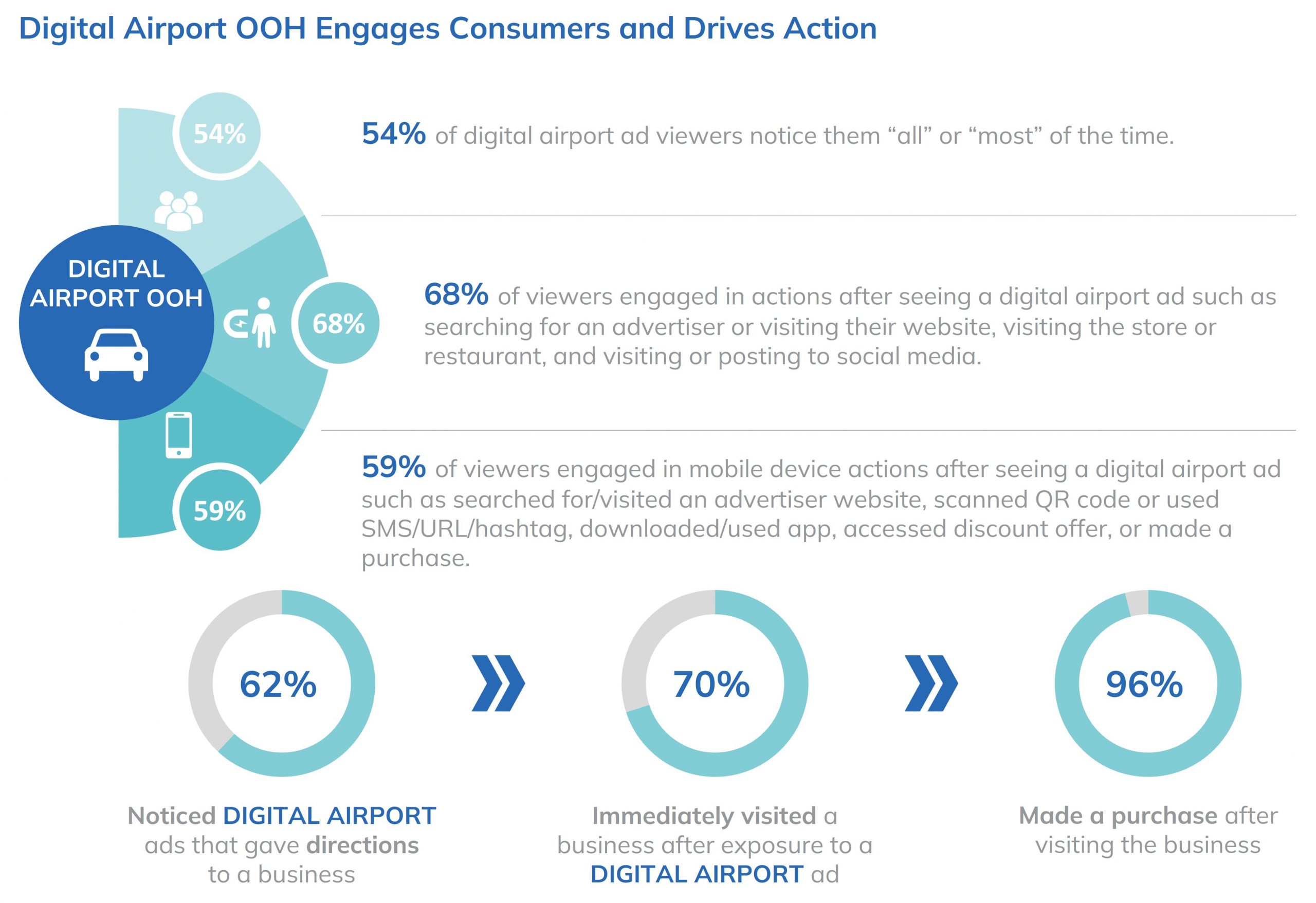
(Image source: oaaa.org)
How to Get Started with Digital Transit Advertising
Today, it’s never been easier for SMBs to get started with digital transit advertising and begin reaping all the huge benefits of reaching the millions of people who use all the various forms of public transportation in towns and cities every day.
All you need is easy and affordable access to the digital screens on and in buses, taxis, Ubers, and trains, and at airports – and that’s precisely what The Neuron provides you with.
The Neuron is a powerful programmatic DOOH (pDOOH) platform designed specifically for SMBs looking to access premium digital screens simply and affordably. Our platform lets you connect directly with media owners so you can find the perfect transit DOOH inventory to suit your campaigns and generate huge brand awareness for your business. Pick your screens, set your conditions, upload your creative, and let The Neuron do the rest.
Our platform even provides you with easy-to-use analytics tools to track your success and gain insights, so you can optimize your efforts and maximize your ROI.
